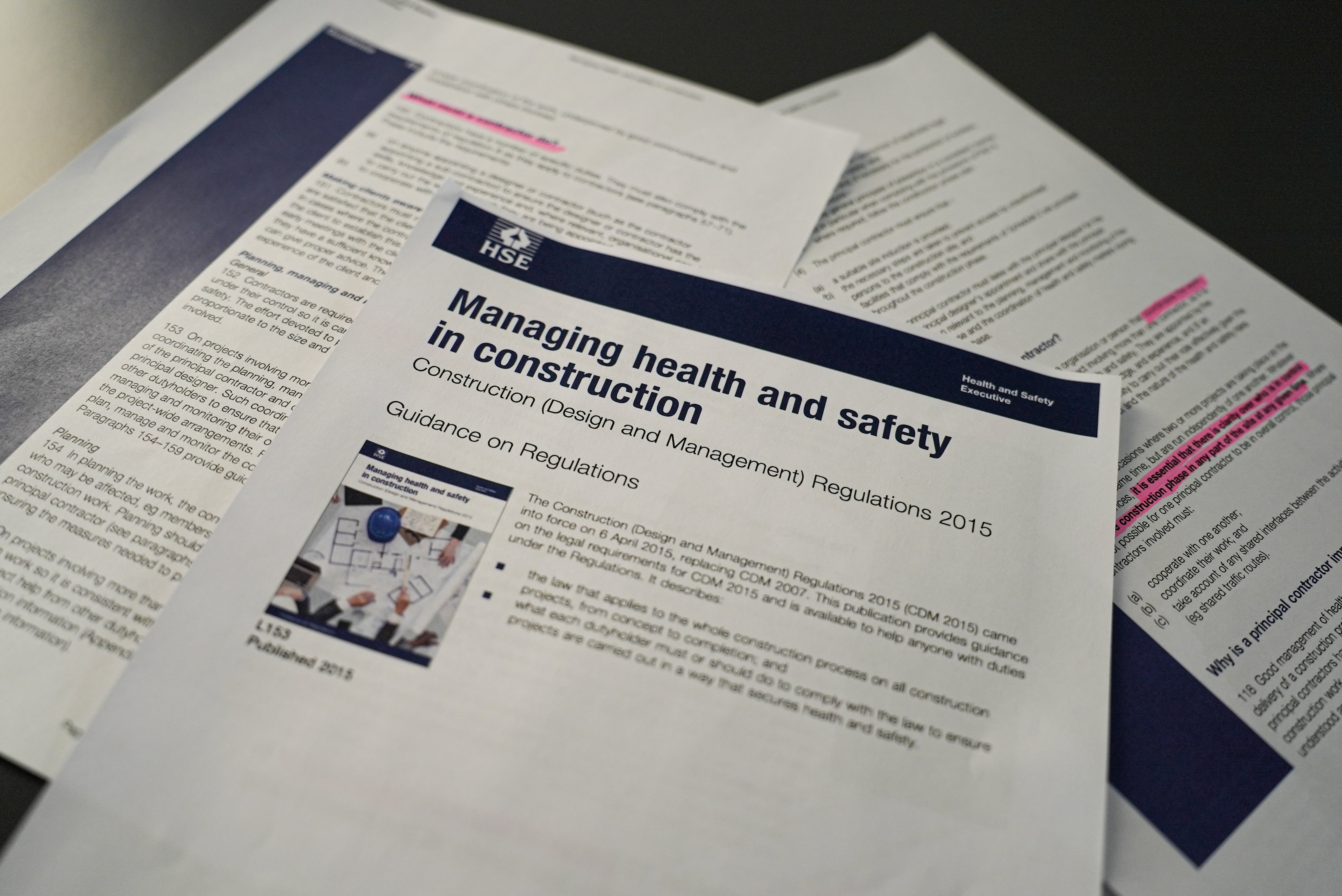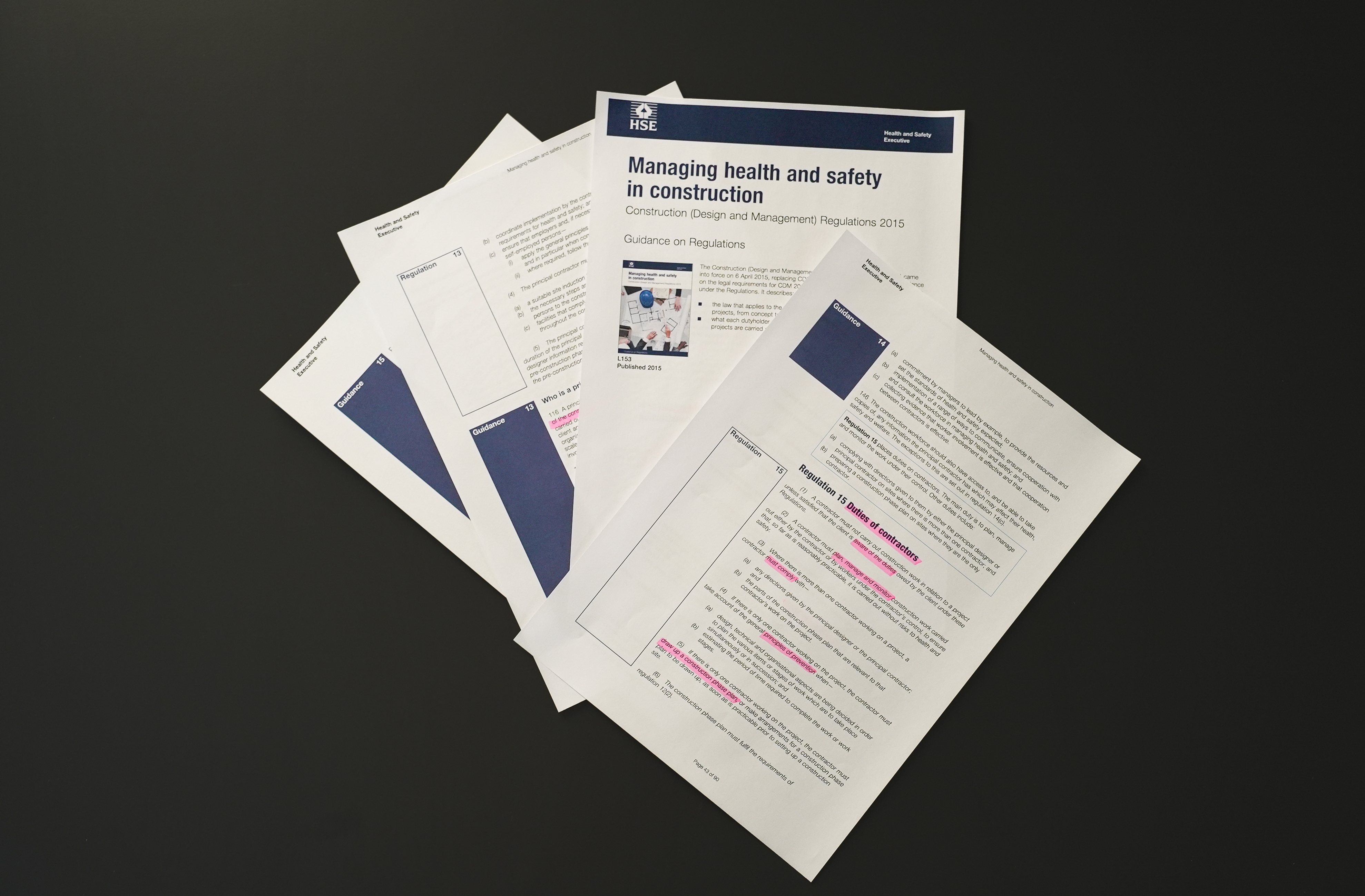A principal contractor refers to an organisation or individual responsible for managing the construction phase activities of a project that involves multiple contractors. This coordination is crucial to ensure the implementation of health and safety measures. The client appoints the principal contractor, who must possess the necessary skills, knowledge, experience, and organizational capability to effectively fulfil their role, considering the project's scale, complexity, and associated health and safety risks.
Efficient supervision of health and safety at the construction site plays a pivotal role in the successful execution of a construction project. Collaborating with the client, principal designer and subcontractors, principal contractors play a significant role in mitigating the risks associated with construction work and offering effective leadership to ensure that standards are comprehended and adhered to.
What are the CDM 2015 Regulations?
And what can you do to ensure health and safety in construction?
If you are a Principal Contractor, the CDM Regulations 2015 outline legal requirements for health and safety in the construction process. The CDM Regulations carry specific guidelines for each duty holder involved in the construction project, including clients, designers, and contractors Whether for domestic or commercial projects, individuals overseeing construction work, known as duty holders, must adhere to CDM 2015 to ensure projects prioritize health and safety.
This piece delves into the CDM Regulations pertaining to Principal Contractors, as outlined in the CDM Regulations Guide, providing valuable insights not only for individuals occupying the Principal Contractor position but also for subcontractors aiming to comprehend the obligations of their Tier 1 contractors. It serves as a resource for M&E contractors to understand how the responsibilities from top-level roles trickle down to subcontractors, highlighting direct consequences and examining possible overlaps in duties.
-
Duty 1 - Planning, managing, monitoring and coordinating the construction phase
-
Duty 7 - Principal contractor’s duties to consult and engage with workers
- Conclusion

Duty 1 - Planning, managing, monitoring and coordinating the construction phase
The principal contractor is obligated to consider the general principles of prevention in the planning, management, monitoring, and coordination of the construction phase. These principles should be considered when making decisions about the sequencing of work and estimating time requirements for specific tasks. The appointment of the principal contractor by the client prior to the construction phase enables close collaboration with the client and principal designer throughout the project's duration.
Planning:
During the pre-construction phase, collaboration with the principal designer is crucial for effective planning and coordination. As the project transitions to the construction phase, the principal contractor assumes a leading role in planning and coordination while maintaining communication with both the client and principal designer. The level of effort exerted by the principal contractor should align with the project's size, complexity, and associated risks, with support from other dutyholders in risk identification and control determination.
In the planning phase, consideration of risks affecting workers, the public, and client employees in occupied premises is essential. Planning must encompass potential construction-related risks, protective measures, provision of appropriate equipment, and resources for organizing, managing, monitoring, and coordinating the work.
Managing:
As the project moves into the construction phase, the principal contractor assumes a leading role in planning and management. Leadership is crucial in managing people to prevent and control risks, requiring visible actions, clear decision-making, and effective communication. The principal contractor must ensure that those engaged in the work are capable, implement preventative measures to control risks, and provide suitable equipment and tools. A systematic approach to management ensures that workers understand project risks, health and safety responsibilities, consistent standards, and incident investigation processes. Good supervision, as part of leadership in health and safety, focuses on risk prevention, commitment to control measures, effective consultation with workers, and addressing unsafe conditions.
Monitoring:
Monitoring standards involves regular checks, allocation of sufficient resources, treating health and safety on par with other business aspects, prompt action when necessary, and utilizing a mix of active and reactive performance measures. Given the rapidly changing nature of a construction site, effective monitoring is essential. This includes routine checks of site access and work areas, plant and equipment, as well as investigating near-miss incidents and injuries. Monitoring is an ongoing process that requires time and effort, with resources set aside during the planning stage.
Coordinating:
Coordination is a specific duty of the principal contractor, ensuring effective cooperation among contractors to manage risks. This involves collaboration between contractors starting work at different stages, with planning meetings to share relevant information. Coordination extends beyond CDM 2015 requirements to encompass compliance with other health and safety regulations. The principal contractor liaises with involved parties to establish a common understanding of health and safety standards and secure cooperation. Cooperation with external entities affected by on-site activities is crucial, especially when coordinating activities across different construction sites to address joint hazards. Regular planning meetings between the principal contractor and subcontractors facilitates effective coordination.
.jpg?width=4240&height=2832&name=DSC01230%20(1).jpg)
Duty 2 - Providing suitable site inductions
Delivering appropriate on-site orientation is crucial. The principal contractor is responsible for ensuring that all on-site workers receive a relevant site induction tailored to the specific site conditions. This orientation must identify any specific risks and communicate the corresponding control measures essential for project personnel. Key considerations encompass:
(a) Demonstrating senior management's commitment to health and safety.
(b) Providing an overview of the project.
(c) Detailing project management procedures.
(d) Outlining first-aid arrangements.
(e) Explaining accident and incident reporting protocols.
(f) Establishing procedures for regularly updating workers, such as toolbox talks.
(g) Describing the process for consulting the workforce on health and safety matters.
(h) Clarifying individual workers' responsibilities for health and safety.
Moreover, site inductions should extend to individuals who do not regularly operate on the site but may visit occasionally, such as architects, or on a one-time basis, like students. These inductions should be proportional to the specific nature of the visit. For escorted visitors, the level of detail in the induction can be less extensive compared to unescorted visitors. Escorted visitors only need awareness of the primary hazards and corresponding control measures.
Duty 3 – Preventing unauthorised access to the site
The primary contractor is responsible for implementing reasonable measures to prevent unauthorized entry onto the construction premises. Collaboration with on-site contractors is essential to physically demarcate site boundaries using appropriate barriers tailored to the site's characteristics and its surrounding environment. Additionally, the principal contractor must take precautions to ensure that only authorized individuals are granted access to the site. Special attention is necessary for sites with the following considerations:
(a) Rights of way passing through them.
(b) Adjacent work areas, such as a shop refurbishment within a shopping centre.
(c) Proximity to occupied houses, particularly on new-build housing estates.
(d) Presence of children or vulnerable individuals in the vicinity, such as schools or care homes located near the site.

Duty 4 – Providing welfare facilities
The principal contractor is responsible for ensuring the provision and upkeep of adequate welfare facilities throughout the construction phase. The determination of what is considered suitable and sufficient depends on the size and characteristics of the workforce engaged in the project. These facilities must be in place before commencement of any construction activities and should be maintained until the completion of the project.
Furthermore, it is essential for the principal contractor to collaborate with other contractors involved in the project to guarantee the provision of appropriate welfare facilities. This collaboration should persist throughout the construction phase, taking into consideration any alterations in the site's nature that necessitate corresponding adjustments to the welfare facilities.
Duty 5 – Liaising with Principal Designer
The collaboration between the principal contractor and the principal designer is essential throughout the project's duration. The client's early appointment of a principal contractor enables the utilization of their construction expertise in the initial stages of project design and planning. Continuous communication with the principal designer is crucial during the construction phase, especially concerning any alterations to the designs and their implications on health and safety risk management.
Effective liaison should encompass compiling information necessary for the principal designer:
(a) to compile the health and safety file.
(b) that could impact the planning and management of the pre-construction phase.
Pre-construction information plays a vital role in planning and managing this phase and subsequently developing the construction phase.
Duty 6 - Working With Domestic Clients
The responsibilities of a primary contractor in a project for a residential client mirror those in a commercial client scenario. They are obligated to fulfil the designated duties in accordance with the project's associated risks.
Duty 7 - Principal contractor’s duties to consult and engage with workers
The primary contractor is responsible for:
- Establishing and maintaining a framework that allows both the primary contractor and construction workers to collaborate effectively in formulating, advancing, and verifying the efficiency of strategies to safeguard the health, safety, and welfare of the workers.
- Engaging in timely discussions with the workers or their representatives regarding any aspects of the project that may impact their health, safety, or welfare. This is necessary unless the workers or their representatives have already been consulted in a similar manner by their employer.
- Ensuring that the workers or their representatives have the right to review and replicate any pertinent information in the possession of the primary contractor, or information required by these Regulations to be provided to the primary contractor, regarding the health, safety, or welfare of workers at the site. This excludes information:
- Whose release could compromise national security;
- That the primary contractor is legally prohibited from disclosing;
- That is specifically about an individual, unless that person consents to its disclosure;
- Whose release might, for reasons unrelated to the impact on health, safety, or welfare at work, significantly harm the primary contractor’s business or, if the information was supplied by another party, that party's business;
- Acquired by the primary contractor for initiating, prosecuting, or defending legal actions.
Engaging workers in health and safety decisions is crucial for maintaining safety in the construction industry. The principal contractor is obligated under CDM 2015 to involve the workforce in health, safety, and welfare matters. This is in addition to the responsibility of all employers to consult with their employees (or their representatives) on health and safety issues under separate legislation.
The primary contractor must consult and collaborate with the workforce to ensure the development, promotion, and verification of effective measures for their health, safety, and welfare. Consultations must be timely and are not necessary if they have already been conducted through a direct employer.
Effective involvement of workers stems from successful consultation and cooperation between the primary contractor and other contractors on site. Certain techniques aid in achieving this goal:
(a) Managers should demonstrate leadership through their actions, ensuring they allocate the necessary resources and establish the benchmarks for health and safety.
(b) Adoption of various methods for communicating with the workforce, promoting collaboration, and involving them in health and safety management.
(c) Gathering proof that the involvement of workers is beneficial and that collaboration among contractors is successful.
Workers in the construction sector should be provided with the opportunity to access and make copies of any information held by the principal contractor that could impact their health, safety, and well-being.
Conclusion
In summary, the principal contractor's duties under the CDM Regulations 2015 are crucial for the safety and success of a construction project. These responsibilities encompass planning, management, worker engagement, and compliance with health and safety standards. The principal contractor is the key figure in coordinating with clients, designers, and subcontractors, ensuring that safety measures are implemented, and risks are mitigated. Their role involves organizing site inductions, securing the site, providing welfare facilities, liaising with the principal designer, and actively consulting with workers on safety matters. Adherence to these duties is essential not only for legal compliance but also for fostering a safe and efficient construction environment, highlighting the principal contractor's pivotal role in upholding safety and efficiency from start to finish of a project.

